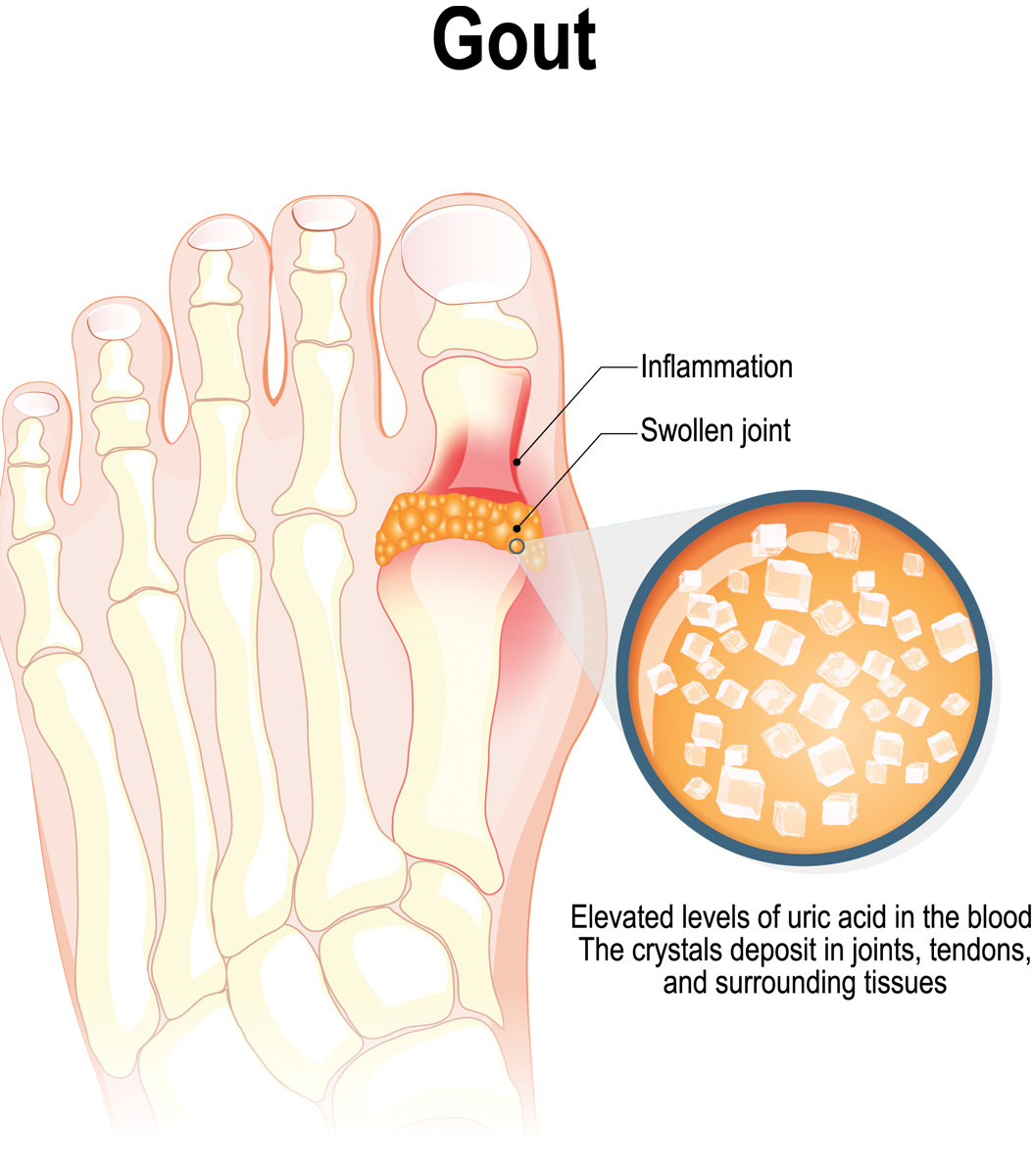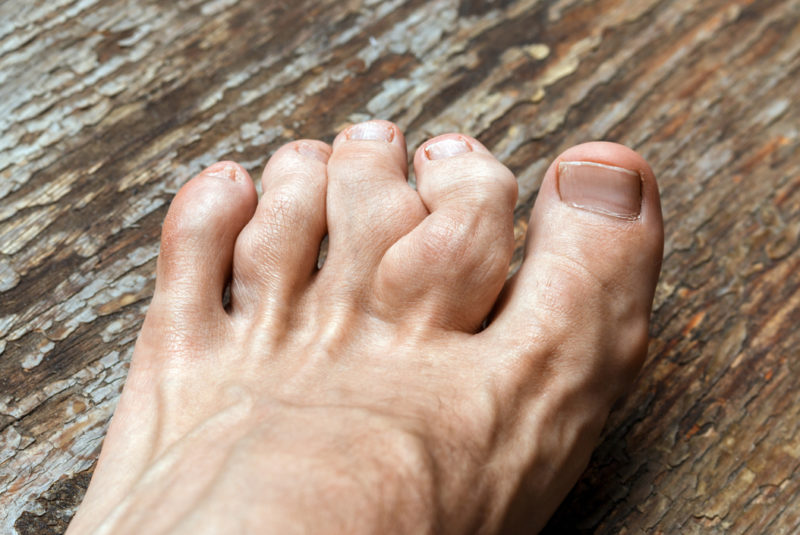What is Gout?
Gout is an extremely painful joint condition that most commonly affects the 1st metatarsophalangeal joint of the big toe (the large joint at the base of the big toe). Gout arises due to high levels of uric acid in the bloodstream. A high level of uric acid is known as hyperuricemia. Elevated uric acid causes small crystals (monosodium urate) to be laid down within joints and the surrounding soft tissues.
Gout is often associated with a diet rich in red meat and alcohol, obesity, and kidney failure. Men are much more likely to suffer from gout than women (9 times more), as are people suffering from rheumatoid arthritis. Gout is also more prevalent with increasing age.
What are the symptoms of Gout?
An attack of gout can happen very quickly and is not associated with a traumatic event. Symptoms of gout include:
- Sudden onset of significant pain in the 1st metatarsophalangeal joint of the big toe.
- A red, hot, and swollen 1st metatarsophalangeal joint.
- Significant pain on touching the affected joint (even attempting to put your socks on can cause high levels of pain).
- Pain on moving the big toe.
- Pain when walking.
What other conditions can present like gout?
Gout vs osteoarthritis of the big toe
Both gout and osteoarthritis cause pain and swelling of the big toe. However, gout is often associated with redness and heat. Osteoarthritis of the big toe typically progresses slowly. It often starts as periodic episodes of pain that settle down independently. Osteoarthritis of the big toe is much more common in an older population (over 50’s) and can occur in men and women alike. In contrast, gout tends to be sudden in onset and may occur in a younger population. Often people suffering from gout will report no previous toe pain. After an attack of gout has passed the toe returns to a normal size and shape and full range of motion is restored. Again, this is not the case with osteoarthritis of the big toe which will become stiffer as time passes.
If you are unsure whether an injection is right for you, we are happy to organise a complimentary phone call with one of our clinicians – Click here to book now
What is Gout?
Gout is incredibly common, affecting 1.4% of the population. It is 3 times more prevalent than rheumatoid arthritis.
Gout occurs when the body produces high levels of uric acid (urate) due to a condition called hyperuricemia. This leads to the formation and deposition of urate monosodium crystals within soft tissues. This results in what we know as Gout.
An episode of gout is triggered when serum urate concentration levels surpass 8.0mg/dL.
Tausche et al (2009)

What causes Gout?
Gout is a systemic rheumatological disease. Little is known about the exact cause of gout, however there are many associated risk factors. These include;
- Gender. Men are up to 9 times more susceptible to Gout. Pre-menopausal women are protected from gout by the hormone, oestrogen.
- A diet rich in purine such as red meat, wild game (Veal and dark) and offal.
- High levels of alcohol consumption (both beer and wine have been implicated)
- Increasing age
- Obesity
- Kidney failure
- Some prescription medications i.e. Thiazide
- Hereditary uric acid disorder however, this is relatively rare.
A Gout attack is typically triggered by a sudden increase in rich food or after consuming alcohol. An attack usually starts with acute pain in a single joint (often the big toe). In most cases, Gout will resolve by itself within a week. Unfortunately, if you suffer from an attack of Gout you have a 90% chance of further attacks over the subsequent 5 years.
How is Gout diagnosed?
Gout is usually diagnosed via your G.P who will ask you a series of questions to uncover any possible causes of the attack (such as a big night out or a change in diet). Your doctor will request blood tests to assess urate serum levels. The most accurate urate serum levels are typically taken 2 to 3 weeks after the attack as often during the attack serum levels remain stable.

Diagnostic musculoskeletal ultrasound has been shown to be a safe and highly effective tool for diagnosing Gout. It has been shown to be highly sensitive at uncovering bony erosions caused by inflammatory arthritic conditions including gout (Fernandez at et. 2017 and Villaverde et al. 2014).
At Complete all our clinicians are fully qualified musculoskeletal sonographers who are experienced in assessing this condition.
How do you treat my Gout?
Medication
Immediate treatment is focused on reducing the acute episode of pain associated with a Gout attack. Your G.P will often prescribe you a nonsteroidal anti-inflammatory medication such as Naproxen, often with a gastric protector drug such as Omeprazole.
If you suffer from Gout regularly your G.P may prescribe a long-term urate-lowering medication such as Allopurinol.
Lifestyle

Long-term management requires lifestyle modification. A healthy diet, reduced alcohol consumption and weight loss will dramatically reduce the chance of further episodes of Gout.
Ultrasound guided injection
An ultrasound-guided steroid injection can be used to reduce the pain and inflammation present during an acute episode of Gout. A corticosteroid is a powerful anti-inflammatory medication that can be deposited within the affected joint. Ultrasound imaging can be used to locate and guide the placement of the medication directly at the epicentre of the Gout. The current evidence base states that ultrasound-guided steroid injections are more effective and more accurate than landmarked injections.
At Complete all our clinicians are highly experienced musculoskeletal sonographers who are able to perform guided injections. Complete run a same-day service with all ultrasound-guided injections. You do not need to be referred by your G.P. All our clinicians are able to fully assess you, perform a diagnostic ultrasound scan, prescribe and carry out an injection in the same appointment.
For further information or to book an appointment please contact Complete on 0207 4823875 or email injections@complete-physio.co.uk.
Other foot and ankle conditions:
References
FERNANDES, E.D.A., BERGAMASCHI, S.B., RODRIGUES, T.C., DIAS, G.C., MALMANN, R., RAMOS, G.M. and MONTEIRO, S.S., 2017. Relevant aspects of imaging in the diagnosis and management of gout. Revista Brasileira de Reumatologia, 57(1), pp. 64-72.
TAUSCHE, A., JANSEN, T.L., SCHRÖDER, H., BORNSTEIN, S.R., ARINGER, M. and MÜLLER-LADNER, U., 2009. Gout–current diagnosis and treatment. Deutsches Arzteblatt international, 106(34-35), pp. 549-555.
VILLAVERDE, V., ROSARIO, M.P., LOZA, E. and PÉREZ, F., 2014. Systematic Review of the Value of Ultrasound and Magnetic Resonance Musculoskeletal Imaging in the Evaluation of Response to Treatment of Gout. Reumatología clínica (English Edition), 10(3), pp. 160-163.


Leave A Comment